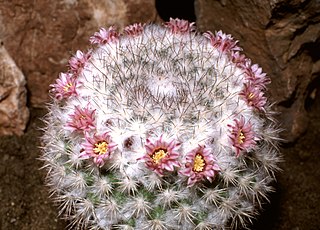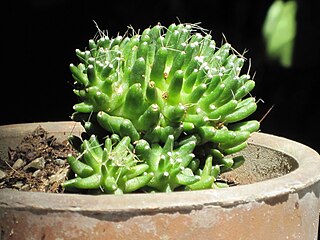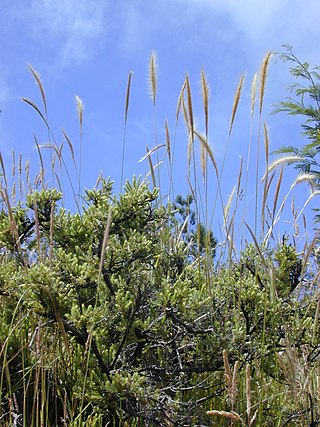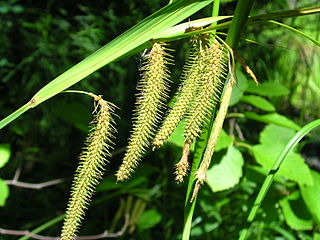
Mammillaria is one of the largest genera in the cactus family (Cactaceae), with currently 200 known species and varieties recognized. Most of the mammillaria are native to Mexico, but some come from the southwest United States, the Caribbean, Colombia, Venezuela, Guatemala and Honduras. The common name "pincushion cactus" refers to this and the closely related genus Escobaria.

Cochemiea is a genus of cactus. It has previously been synonymized with Mammillaria, but molecular phylogenetic studies have shown that when broadly circumscribed, Mammillaria is not monophyletic, and Cochemiea has been accepted as a separate genus.
Neolloydia is a formerly recognized genus of cacti. The genus was first erected by Britton and Rose in 1922. Edward F. Anderson regarded Neolloydia as being poorly defined, with the result that species that had at times been included in Neolloydia were afterwards placed in multiple genera, including Coryphantha, Echinomastus, Escobaria, Mammillaria, Sclerocactus, Thelocactus and Turbinicarpus. In his 2001 book, Anderson firmly placed only one species in the genus, Neolloydia conoidea, with another, Neolloydia matehualensis, being regarded as only a variant of N. conoidea. As of December 2022, Plants of the World Online treated Neolloydia conoidea as a synonym of Cochemiea conoidea, and Neolloydia as a synonym of Cochemiea.

Dypsis crinita is a species of flowering plant in the family Arecaceae. It is found only in Madagascar. It is threatened by habitat loss.

Mammillaria painteri is a species of plant in the family Cactaceae. It is endemic to Mexico. It is usually found near, but not limited to, San Juan del Rio, Guanajuato. It is commonly referred to as the biznaguita in Spanish. It is also known by many to be synonymous with Mammillaria crinita subspecies crinita. It was evaluated and added to the IUCN Redlist in 2002 as data deficient. The causes of this species' endangerment or threats to its well-being are not clear.

Mammillaria zeilmanniana is a species of cactus. It is endemic to Mexico, where it is known only from Guanajuato. It grows in a narrow canyon usually near water where there is high humidity, its total population is fewer than 250 individuals. It is threatened by illegal collection for the horticultural trade. Recent studies link this species to Mammillaria crinita.

Mammillaria rhodantha, the rainbow pincushion, is a plant in the cactus family (Cactaceae) and is one of 171 species in the genus Mammillaria which are characterized by having nipple-shaped tubercles or prominences on their surface.

Mammillaria spinosissima, also known as the spiny pincushion cactus, is a species of flowering plant in the cactus family Cactaceae, endemic to the central Mexican states of Guerrero and Morelos, where they grow at elevations of approximately 1,600 to 1,900 metres. The species was described in 1838 by James Forbes, gardener of the Duke of Bedford. Botanist David Hunt collected a specimen in 1971, when he located one near Sierra de Tepoztlan, Mexico.

Dichelachne crinita , commonly known as the longhair plume grass, is a type of grass found in Australia, New Zealand and islands of the Pacific Ocean. It is often seen on sandy soils near the sea as well as woodlands. The flowering panicles are open and feathery at maturity. The grass may grow up to 1.5 metres (5 ft) tall. Crinita, the specific epithet, is derived from Latin (hairy).

Mammillaria carnea is a species of cactus in the subfamily Cactoideae.

Mammillaria columbiana is a species of cactus in the subfamily Cactoideae.

Mammillaria brandegeei is a species of cactus in the subfamily Cactoideae.

Mammillaria muehlenpfordtii is a species of cactus in the subfamily Cactoideae.

Alsophila crinita, synonym Cyathea crinita, is a species of tree fern native to India and Sri Lanka. It is considered to be endangered.

Carex crinita, called fringed sedge, is a species of flowering plant in the genus Carex, native to central and eastern Canada and the central and eastern United States. It is the namesake of the Carex crinita species complex.

Mammillaria pringlei, called the lemon ball, is a species of cactus in the genus Mammillaria, native to Mexico, from Querétaro through to Veracruz and on to México State. It has gained the Royal Horticultural Society's Award of Garden Merit.

Mammillaria petterssonii is a species of cactus in the genus Mammillaria, native to northeast and southwest Mexico. It has gained the Royal Horticultural Society's Award of Garden Merit.

Mammillaria laui is a species of cactus in the genus Mammillaria, native to Tamaulipas state in Mexico. A number of subspecies were described, occurring along an elevation gradient; these are no longer accepted. It is listed as Critically Endangered (CR) in the wild. As Mammillaria lauii it has gained the Royal Horticultural Society's Award of Garden Merit.

Guazuma is a genus of flowering plants belonging to the family Malvaceae.

Mammillaria hernandezii is a species of cacti in the tribe Cacteae. It is native to Mexico where it has a disjointed distribution in a small area of upland tropical pine scrub. There are estimated to be fewer than 500 plants in the wild and is classified as endangered.



















